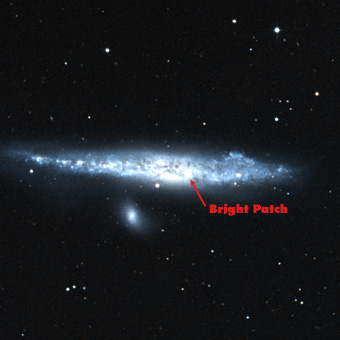| Interacting
Edge-on Spiral Galaxy
aka Arp 281, PGC 42637, MCG 6-28-20, Uppsala 7865 Integrated Visual Magnitude: 9.7 Apparent Diameter: 14.8' x 2.6' Mean surface brightness: 22.3 mag/arc-sec2 Minimum requirements to view: a 4-inch scope under dark skies |
 Every
once in a while you stumble upon a truly neglected showpiece, and NGC 4631
is one of these. Although Burnham's has a picture only with no text,
and Walter Scott Houston didn't write about it at all, this is one of the
more interesting galaxies in the entire sky. To be fair, it does
appear in the Caldwell catalog, SAC 110 best NGC objects,
and RASC finest NGC objects lists. But even then, I don't
believe it has gotten the attention it deserves.
Every
once in a while you stumble upon a truly neglected showpiece, and NGC 4631
is one of these. Although Burnham's has a picture only with no text,
and Walter Scott Houston didn't write about it at all, this is one of the
more interesting galaxies in the entire sky. To be fair, it does
appear in the Caldwell catalog, SAC 110 best NGC objects,
and RASC finest NGC objects lists. But even then, I don't
believe it has gotten the attention it deserves.
Sometimes referred to as the Whale or Herring galaxy, NGC 4631 is large yet has high surface brightness, making it readily visible in smaller instruments and very interesting in larger ones. By way of comparison, the famous Sculptor galaxy, NGC 253, has the same mean surface brightness. A tiny companion galaxy, NGC 4627, is visible just to the north of the center. This 13th mag galaxy can be glimpsed in a 6-inch scope. In addition, if you have a wide enough field of view, you may be able to treat yourself to both NGC 4631 and the nearby NGC 4656 in the same field.
Larger instruments may reveal fine detail at high magnification that is remarkable. Be sure to look for the bright patch to the east of center (pictured).
My first view of NGC 4631 came in the spring of 2001 in my 18-inch f/4.5:
I was really taken with this galaxy! It is large and bright with lots of texture and a nearby companion. The high surface brightness allowed me to use 480x on it without difficulty. A star can be seen silhouetted against the galaxy near the center. Most interestingly, I saw up to three bright knots near the plane of the galaxy. Eerily, they seemed to come in and out of focus, like bad seeing, yet the nearby star remained steady. I returned later but no longer saw the three knots. Instead, I saw only one of them, very near the galaxy's center. It appeared as a small round smudge superimposed on the galaxy.The latter turned out to be the bright patch pictured.
The companion galaxy, NGC 4627, appeared as a faint oval patch. It wasn't exactly obvious, but I wouldn't call it difficult either.
This is the first object in some time that really wowed me at the eyepiece. If you haven't seen it, what are you waiting for?

The view in a 6-inch at 50x. Note the nearby galaxy NGC 4646, nearby in the same field. North is down and east is to the right.
| Millennium
Star Atlas Vol II Chart 654
Sky Atlas 2000 Chart 7 Uranometria 2000 Vol I Chart 108 |